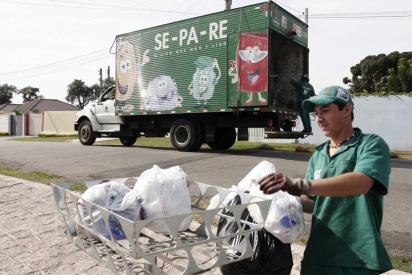
2 minute read
Figure 3.13 Curitiba’s Waste Program
The Green Exchange Program was also started in Curitiba’s slum areas that are inaccessible to waste collection vehicles (fi gure 3.13). To encourage the poor and slum dwellers to clean areas, and thereby improve public health, the city began off ering bus tickets and vegetables to people who brought garbage to neighborhood centers. In addition, children have been allowed to exchange recyclables for school supplies, chocolate, toys, and show tickets. The city purchases vegetables at discounted prices from farmers who have trouble selling abundant products. Through this program, the city saves the costs of arranging waste collection in slum areas, which often have inadequate roads, and helps farmers unload surplus produce. The program also helps improve nutrition, accessibility to transportation, and entertainment opportunities among the poor. Most important, slums are cleaner and have less disease incidence, and less garbage is being dumped in sensitive areas such as rivers.
The Industrial City of Curitiba
Advertisement
In the 1970s, Curitiba’s economy was based mainly on the service sector. To attract investment, boost employment, and reduce poverty, IPPUC decided to introduce manufacturing industries. To further this goal, the local government established the Industrial City of Curitiba on the city’s west side, taking into account wind direction to avoid polluting the central city. The industrial park has extensive green areas encompassing 4,300 hectares and is well connected to the bus network. Many employees at the industrial park live nearby and commute by bicycle. The industrial park has strict environmental regulations. Polluting industries are not allowed.
After three decades, the Industrial City of Curitiba now hosts more than 700 companies, including global fi rms such as information technology companies and an automaker producing BRT buses. It has created about 50,000 jobs directly and 150,000 jobs among secondary industries. About 20 percent of the exports of the State of Paraná originate in the industrial park, and the industrial park accounts for 25 percent of the industrial tax revenues (state value added taxes on sales and services) of the State of Paraná (Hattori 2004; Prefeitura Municipal de Curitiba 2009).
Social considerations
Although Curitiba’s economy is relatively well developed compared with the economies of other Brazilian cities, many poor people still live in slums. To encourage the poor to obtain jobs and to promote an inclusive community, Curitiba has adopted various innovative social approaches.
The city converted the undeveloped land under a high-voltage line in a southern area of the city into a “job line” that helps people start businesses and encourages the growth of the local

Figure 3.13 Curitiba’s Waste Program
Source: Photos courtesy of IPPUC. Note: The Garbage That Is Not Garbage Program (left) and The Green Exchange Program (right).





